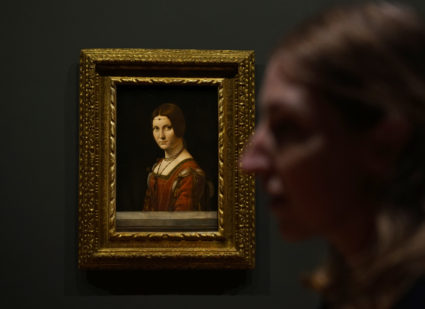
5 things we learned at the Louvre's historic Leonardo da Vinci exhibit
If you had to name the most famous painting in the world, there's a better-than-average chance you'd name the "Mona Lisa" — the jewel of the Musée du Louvre, and one of the iconic artworks that immortalized the name Leonardo da Vinci. That crowd-pleasing painting is not in a monumental new da Vinci exhibit that opens in Paris on Thursday to mark the 500th anniversary of the Renaissance artist's death. With so many other treasures, it's not entirely missed.
Fewer than 20 paintings by the self-taught Italian master are known to exist today — and several of those don't make an appearance in this show.

But the museum took over 10 years to bring together more than 160 drawings, manuscripts, sculptures, and yes, paintings, by the artist and his circle of students. The exhibit traces da Vinci's time under the tutelage of noted Florentine painter and sculptor Andrea del Verrocchio; da Vinci's own artistic evolution, complete with drawings that demonstrate his interests in botany, engineering, geometry and human anatomy; and ending with his last years spent in France, where he died in 1519.

Amid the much studied masterpieces are unfinished works like "Saint Jerome," whose face is far more detailed than the lion that lies by his feet. The exhibit, too, is punctuated with meticulous drawings of the human body (muscles, movement of the arm, proportions of the head, etc.), of plants, of mathematical studies, of imagined flying machines, and so forth.
With few finished works of art to his name compared to other Renaissance masters, da Vinci has historically been seen as a brilliant procrastinator, or an artist who went down many "detours."

The Louvre exhibit, however, frames it differently. Curator Vincent Delieuvin said da Vinci's pursuits demonstrated an "original way to paint." He was not interested in painting thousands of portraits, frescoes or many different variations of the Madonna.
"He decided to base his art on science, but as he wanted to reproduce all nature, he had to understand all the nature," Delieuvin said. "So he took a long time studying geometry, mathematics, optics, [botanicals], anatomy, everything on Earth, to be able to reproduce it in his paintings."
Da Vinci preferred to paint perfect pictures, he added, even if that meant, in the end, "only a few, but wonderful ones."
Here are five things to know from the Louvre exhibit about da Vinci's approach to art.
1. Mona Lisa's good "vibrations" are not forgotten.

There has been a lot of discussion about what is and isn't included in the decade-in-the-making exhibit. Several of the masterpieces are here. The lady in "La Belle Ferronniere" carries a trademark inscrutable expression. A copy of his "The Last Supper" mural overlooks rows of da Vinci's drawings. "Benois Madonna," borrowed from St. Petersburg, shows the infant Jesus gingerly cradling his mother's hand. In "Portrait of a Musician," something draws the man's attention out of frame, while "Saint John the Baptist," the long-haired religious figure, points toward the heavens with a smile.
So why is the "Mona Lisa" omitted?
Simply: It's too popular. The painting, housed elsewhere in the Louvre, can receive about 30,000 visitors a day. The line to see her is long, as each group has about 10 seconds to walk up and get a selfie with the painting.

However, she isn't totally absent from the show. The iconic artwork is instead represented by an infrared reflectograph, which allows art historians and conservators to see details that aren't superficially visible, and a virtual reality section at the end of the exhibit that explores the story behind the famous painting.
Delieuvin said that da Vinci wanted to give his paintings "vibrations" — and the "Mona Lisa" is a prime example of that effect.
"When his contemporaries discovered the 'Mona Lisa,' they were terrified because Leonardo painted a woman living, clearly living." At the time, there were no pictures, no photographs, no videos. "And so, for them, Leonardo was like magic," among the first to give a painting "real life," he added.
Separately, prior to the much-hyped da Vinci exhibit, Louvre officials swapped the yellow backdrop of the "Mona Lisa" for a more complementary midnight blue, Artnet reported.
2. At the last minute, the "Vitruvian Man" joins the exhibit for a limited time.
Leonardo da Vinci's "Vitruvian Man," a drawing recognizable by its pen-and-ink study of the male figure's proportions, is about 530 years old and one of the artist's most famous works.
Serge Bramly, author of "Leonardo: The Artist and the Man," said the drawing points to one of da Vinci's chief interests: nature.
"Nature is the master of true intellectuals, to painters, everything," Bramly said. "But when [da Vinci] sees nature, when he says nature, he means the nature of things. You are nature. I am nature. … If there is one reality for everything, then maybe there is a law, mathematical law, preferably that could define everything," such as the human body.

The drawing was also the subject of a contentious back-and-forth over whether it would be featured in the exhibit.
As with most old drawings, the "Vitruvian Man" is a delicate work that cannot be exposed to light for long periods of time. It was the drawing's fragility — and its deep connections to Italy — that prompted a heritage group known as Italia Nostra to issue a last-minute appeal in court to try to block the loan of the drawing to France.
But in the end, an Italian court ruled that the drawing can travel as long as its time in the Louvre is limited, among other conditions. As a result, "Vitruvian Man" will be displayed in Paris for only two months.
As part of a previous agreement between Italy and France's culture ministers, the Louvre will lend a few works by Raphael in its collection to Rome for an exhibit next year.
3. .sgniward sih ta kool resolc a ekaT

Pages of notes and drawings in the exhibit offer an inside look into da Vinci's varied interests and ideas. But you may not get very far in reading his writing if you're expecting something traditional.
If you look closely, you'll notice that he wrote backward.

Museum staff explained that da Vinci was left-handed and that many of his written objects owned by the museum are in this "mirror writing" technique. As that name suggests, da Vinci's writing could be better read if a mirror was held to the words.
It's unknown when da Vinci started writing from the right side of the page to the left, and there are some theories that maybe he wrote this way to hide something. But Louvre officials think it was for practical reasons, that da Vinci may have been avoiding smudging his ink, a problem familiar to many left-handed people.
4. The "Salvator Mundi" painting remains MIA.

The painting "Salvator Mundi" depicts a Jesus in Renaissance garb holding a crystal orb in one hand and making the sign of the cross with the other. The attention paid toward da Vinci in recent years has been driven in part by some mysteries around this particular painting.
While experts generally attribute the painting to da Vinci, some have disputed the connection. And when the painting was sold at a 2017 auction at Christie's for $450 million — a new auction record for an artwork — the new owner was not revealed.
For now, a copy of "Salvator Mundi" appears in the Florence section of the Louvre exhibit, next to "Saint John the Baptist," believed to have been painted by da Vinci around the same time.

Asked if he was disappointed that some da Vinci artwork, including "Mundi," did not make it to the Louvre, Delieuvin said that when you're a curator of an exhibit, "you are a little bit crazy."
"You want everything," he said. "But at the end, sure, I would like to have maybe one or two pieces more, but we have already 160 pieces."
"What we wanted to say on Leonardo da Vinci is already there, and expressed with the works we have here," he added.
5. Other artists pictured the famed portraitist with a Merlin beard.

There are now two known images of da Vinci. That wasn't always the case. But earlier this year, scholars believed they discovered a second image, when the British royal family looked more closely at a sketch they had of a bearded man.
A portrait of a man, whose nose and beard struck a resemblance to Francesco Melzi's depiction of da Vinci, is believed to have captured the artist's later-in-life "philosopher" look. Scholars believe the sketch, which also has a study of a horse's leg on the same page, was done not long before da Vinci's death in France.
Melzi's sketch of his teacher appears at the end of the Louvre exhibit, showing a da Vinci in greater detail, a flowing beard we've come to associate with the Renaissance artist.
Paris-based journalist Camille Février contributed to this report.
Support Canvas
Sustain our coverage of culture, arts and literature.



















